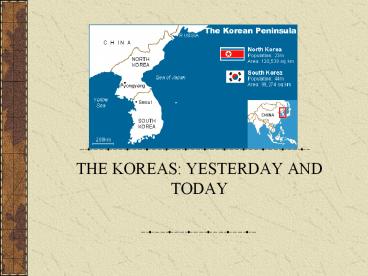THE KOREAS: YESTERDAY AND TODAY PowerPoint PPT Presentation
Title: THE KOREAS: YESTERDAY AND TODAY
1
- THE KOREAS YESTERDAY AND TODAY
2
The Korean War
- A Quick History
3
THE COLD WAR
- After World War II, the world was divided into
two main superpowers, the democratic United
States, and the communist Soviet Union. - The struggle between the two was called the Cold
War. - After WII, Korea was divided along the 38th
parallel into North and South Korea - North Communist w/ command economy
- South Free Nation w/ free market
4
The Cold War
- The stated objective of the U.S.A., known as the
Truman Doctrine, was simple stop the spread of
communism wherever it begins. - The Soviet Union had a similar goal help the
spread of communism wherever it begins
5
THE COLD WAR
- Although the US and the USSR never actually met
on the battlefield, they supported their allies
in a number of Proxy Wars. (Wars fought to assist
others.) - The two most famous Proxy Wars took place in
Korea and Vietnam.
6
North Korea Invades
- On June 25, 1950, 90,000 communist troops poured
over the 38th parallel into South Korea. - Within three days, the communists captured Seoul,
South Koreas capital city.
7
NORTH KOREA INVADES
- One day after the invasion, U.S. President Truman
called for U.S. military forces to aid S. Korea
in stopping the communists.
8
AMERICA RESPONDS
- Although the U.S. supplied the bulk of the
foreign troops, England, Australia, and 14 other
nations participated. - US forces were under the charge of Gen. Douglas
MacArthur. - The Soviets did not send troops into Korea but
financially supported the invading communists.
9
America Responds
- MacArthur, a staunch anti-communist, was not only
interested in pushing the North Koreans back, but
also punishing them for their invasion. - By September 29, The U.S. forces reached the 38th
parallel, reestablishing the Korean boundary.
10
Mao and Stalin Supported North Koreas Invasion
of South Korea
- By early October, MacArthur had entered North
Korea with the intention of overthrowing the
communist government. - Meanwhile, communist China under Mao Tse-Tung
(ZeDong) vowed to stop MacArthur. - Picture Mao and Stalin (Theres a story!)
11
ENTER CHINA
- Over the next several months, a million communist
Chinese soldiers entered Korea. - MacArthur vowed to regroup, recapture North Korea
and overthrow Mao.
12
ENTER CHINA
- The Chinese promised to push MacArthur to the
sea. - MacArthur asked Washington D.C. if he can use
atomic weapons against China. Washington refuses.
13
ENTER CHINA
- By January, 1951, The Chinese had taken the South
Korean capital of Seoul. Things did not look
good. - Eventually, the U.S. sent in enough troops to
stop the Chinese, and push them across the 38th
parallel.
14
AMERICA REBOUNDS
- MacArthur complained about not getting to invade
China and drop atomic bombs. - President Truman fired him.
- MacArthur is remembered as an American hero.
15
(No Transcript)
16
STALEMATE
- The Korean War eventually dragged into a
stalemate, a battle in which neither North
Korea/China nor the U.S. made any significant
gains. - On July 27, 1953, a ceasefire was signed, thus
ending the war. Contrary to North Koreas plans,
South Korea remained a free nation.
17
STALEMATE
- The war cost the U.S. 54,000 lives and over
100,000 casualties. - Over 2 million Koreans died.
18
The Koreas Today
19
Camp Bonifas at the 38th Parallel
20
President Obama at the DMZ
21
PYONYANG, NORTH KOREA
22
- North Korea spends a great deal of money on the
development of their military, nuclear, chemical
and biological weaponry, yet depends on foreign
aid to feed its people.
23
Over 30 of N. Koreas GDP Comes from Farming.
Pay attention to the technology.
24
- SEOUL, KOREA
25
South Koreas Hyundai Shipping Yard South Korea
5th in Automotive World Production and 6th in
Automotive Exports
26
(No Transcript)
27
South and North Korea Data Comparison (Standard
Living)http//geography.about.com/library/cia/blc
southkorea.htm
NORTH KOREA NORTH KOREA NORTH KOREA NORTH KOREA NORTH KOREA
Life Expt Literacy Rate GDP Purchase GDP Break-down GDP Per Capita
Male 69 yrs. Female 74 yrs. (2005) Male 99 Female 99 (2005) 40 million (2004) Farming 30.2 Industry 33.8 Service 36.0 (2004) 1,700 (2005)
SOUTH KOREA SOUTH KOREA SOUTH KOREA SOUTH KOREA SOUTH KOREA
Life Expt Literacy Rate GDP Purchase GDP Break-down GDP Per Capita
Male 73 yrs. Female 81 yrs. Male 99 Female 97 (2004) 925.1 billion (2004) Farming 3.2 Industry 40.4 Service 56.3 (2004) 19,200 (2004)

